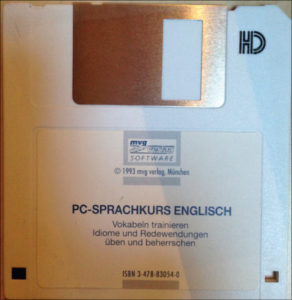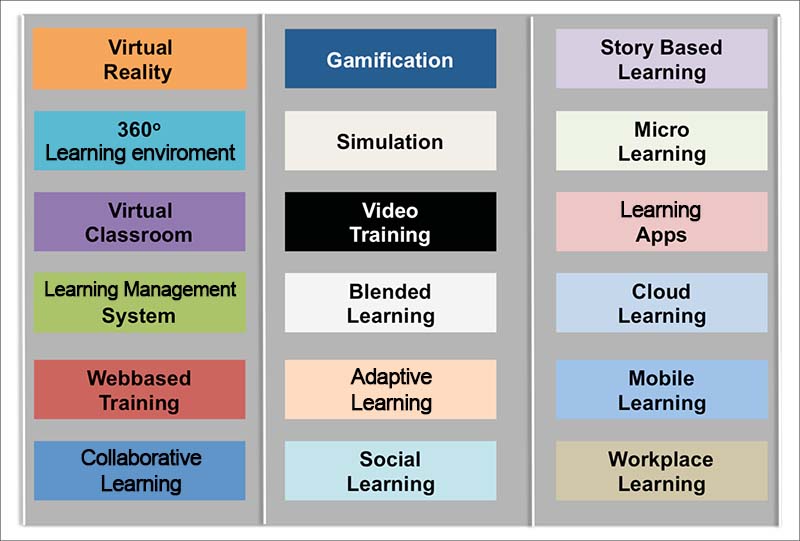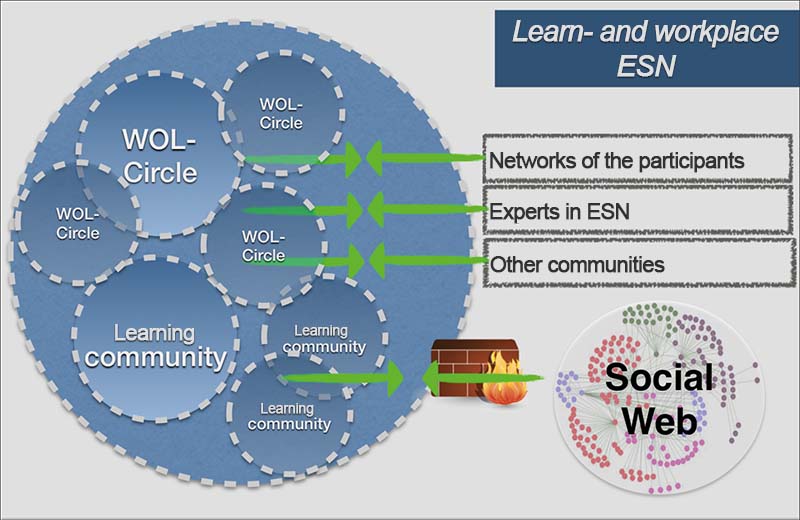We seem to be in a time of arrival: eLearning in companies and future trends in eLearning. The latter usually emphasizes the need to look beyond technological buzzwords to future trends. At the same time, the buzzword of digitization seeks to formulate requirements for learning technologies that encourage learning and meet the requirements for measurable and sustainable improvement. But do working world 4.0 and didactic-methodical paradigms of the age 1.0 fit together? One possible solution: embed eLearning in another context.

Somehow, it’s all digitalization, isn’t it?
Digitization, AI (artificial intelligence), bot, digital workstation, virtual / mixed reality and more have become just as fluid as the concept of eLearning. At least we have already heard of this, which is equally true of the old term eLearning. After all, eLearning has not yet arrived everywhere. But we all know what this is all about, namely learning with the help of electronic media and instruments, and the methodological subtleties and refinements do not play a role for the time being.
Electronic, as we already feel when pronouncing, seems just as outdated as the PC language course on disk in the 90s of the last century. Digital would also apply, and this would be hyper, but not necessarily more helpful. Digitization is everywhere, both professionally and privately, but is usually not associated with this term.
If we approached a person in his mid-60s in the ice cream parlor and said: “Great, you are actively participating in the digitization”. Then the person in question would probably look surprised and answer: “No, not really, I’m just posting the picture of this delicious ice cream on Facebook.
On closer inspection, we recognize that digitization implies an image upload (after all, it is what makes it possible), but that a further differentiation with regard to the behavior of users such as sharing, networking or likening and commenting captures activities and thus approaches what we basically mean by digitization. It is not technology, but action and behavior using digital media. Action and behavior are what we want to promote with training and eLearning, but basically do not come up with the possibilities and requirements of a 4.0 world for future action and behavior. If the current opportunities that we are experiencing through technology are already challenging us, we (just think of bots and AI) cannot really grasp today how we will interact with these new colleagues tomorrow. Will they, self-learning, be smarter than any eLearning?
Why does digitization receive a relatively large space at the beginning of this article?

Well, partly because we live in the digital age. An age of economic, social and economic upheaval. In private and at work. We no longer speak here of a creeping, but of a rapid change, not a few of revolution. A change that we can still avoid in our private lives, but surprisingly often do not. In the car, in the thermomixer, at the baby phone via smartphone, smart TV / home – wherever we see a direct benefit, we are happy to help. And if we have problems getting started, we get help on the Internet or online in the manual, learn playing ukulele via YouTube or book an online teacher on a platform like Preply.
Millions of autodidacts set off on the Internet without even thinking about the fact that they are basically doing an eLearning course. “I taught myself that with…” would probably be the statement and not “I attended a training course on YouTube”.
This small example alone illustrates the essentials:
- People set out when they feel a need.
- They cover this demand themselves in the digital media.
- If they are stuck on their own, they seek advice in forums and/or networks.
- They apply what they have learned immediately and directly.
- They do not worry whether they are learning, even with e- or mobile learning, and are also quite willing,
to accept the one or other unprofessionality of video explanations. - And also look at the market of apps, also with fun, curiosity and joy in doing, i.e. learning.
Digitization is not the subject of all of the above, and it may well be doubted that it is even consciously perceived.
Doesn’t have to, unless we’re training providers. Because as a provider, we offer users our educational services. This now has to fit the time, the said digital. And so, we have arrived in the middle of the so-called digital education, as it were the educational technology park, whose individual buildings could be called: mobile, adaptive, web-based training, virtual classroom, etc.
We are confronted with an almost inexhaustible variety of concepts, whose differentiation is characterized on the one hand by the technological implementation, and on the other by planned behavioral patterns of the actors (trainers and learners). The examples in Figure 2 reflect the categories of various national and international eLearning awards. There are fixed rules for the planned behavior patterns: someone prepares the knowledge didactically and methodically in such a way that the theoretical knowledge can be acquired in the best possible way (ideally fully motivated and with fun), practiced in a protected, closed classroom and then transferred into private and / or working life. These pedagogically standardized behavioral patterns now make it possible to make full use of the technological possibilities within the respective category.
Now many categorizations may promote the specialization of providers in the education industry and thus serve as unique selling points. Perhaps only for a limited time, however, because disruption in the education sector does not occur on the part of education providers, but on the part of users. Why should employees have to withhold their talents and expertise in e.g. sketching or creating videos, one-pagers etc. from the company, because “explaining and explaining (= offering learning) is institutionally firmly anchored and assigned to defined categories? Methods such as Working Out Loud, which find unstoppable and extremely successful dissemination, give employees a (publicly learning) voice. A “Learning Out Loud” in a closed classroom, on the other hand, will hardly be heard by anyone outside the group.
So educational crowdsourcing in the future?
There is a quotation that is often used for motivational purposes: If Company X knew what Company X knew. The aim is to motivate ESN employees to share knowledge and experience during the ongoing work process so that others can participate, simplify or improve their work and thus create added value for individuals and the company. This sounds logical, makes sense, and the multitude of practical examples documents the success. So, isn’t it obvious to rely entirely on the wisdom, self-organization and creativity of the many in the company and to trust that wiki gardeners and community managers will see to it?
However, those mentioned lack what guarantees good education: pedagogical competence. And even though the wisdom of many may reveal a considerable amount of knowledge, didactic-methodical preparation does not necessarily distinguish the knowledge provided. Even if the scenario just outlined requires urgent corrections, is there still a not small core of truth in it? This consists in the fact that the sharing of knowledge and experience of employees from all kinds of further education, namely with the beginning of the design of learning scenarios, must no longer be ignored. Even in teaching scenarios.
There is no need for powerful tools like an ESN, which simply cannot be afforded by every company. However, ESN-like solutions can also be found in SMEs, whose objectives also include sharing knowledge and collaboration as well as co-creation. Now one could exaggerate that a pedagogy does not aim at sharing, but at (tested) imparting knowledge, and this, depending on the use of the various technological possibilities, in the (virtually) training orchestrated (virtual) classroom with different methods (blended, gamification, etc.). Tested, bookable and thus formally as classified as learning, whether with “e” or “m” or without and under the scrutiny of those responsible for the image. Efforts to get a grip on so-called informal learning may hopefully be doomed to failure if they are based on the conventional understanding of education.
Both, the sharing of knowledge and experience of many on the one hand and the provision of knowledge via eLearning on the other, currently seem to be moving forward on two independent tracks. In the following, possible stops are sketched, which may be useful to create an educational station (to stay in the picture) that travelers (learning employees) use in a self-organized manner according to their personal and/or common destination.
eLearning faces a double challenge
Predicted may seem as if the downfall of what we subsume under eLearning is being proclaimed. This is far from being the case. Rather, it is about broadening one’s perspective and closing ranks with changes in the company on the other. is far from that. Rather, it is about broadening the perspective on the one hand and joining forces with changes in the company on the other.
If we only go back to a few examples of the categories in Figure 2, we immediately recognize the potential of eLearning. Here are just a few examples:
- the winning project of the eLearning AWARD 2017 in the category Simulation (Training in the virtual Gotthard Base Tunnel – highly innovative 3D simulation environment for education & training).The project description1 clearly shows that learning in this virtual simulation environment is far superior to training in analog space. The spectrum of the training covers all facets of modern learning offers, far beyond knowledge transfer. A 3D learning environment is the ideal and rightly award-winning learning environment for employees.
- the winning project of the eLearning AWARD 2017 of the category Compliance Training (Basics of data protection, IT compliance and know-how protection – knowledge transfer about the careful handling of data and information). Which company is not confronted with compliance issues or the issues of labor law and occupational safety? Many of these legal requirements must be verifiably trained and beyond that, because of the law or regulation, cannot be discussed. Sharing knowledge and experience could certainly inspire one or the other learning effect, but would not be necessary for the acquisition of knowledge from, which the corresponding behavior should be derived.
The examples given are intended to illustrate two aspects:
- Where a separate room (e.g. 3D learning environment) offers the optimal solution, this room should be created and used as far as possible. The winning project shows that it is not only knowledge that can be transported, but also behavior that can be practiced and thus action competence acquired, making transfer performance after training obsolete.
- Where non-disputable content has to be conveyed and this conveyance also has to be proven, eLearning can be embedded in a Learning Management System, even if, as in most cases, there is no interface to an ESN, but very well to the HR systems. This is the best way to efficiently meet legal requirements.
In addition to the examples mentioned above, there are numerous other examples that impressively prove the justified existence of “conventional eLearning”. Without wanting to advertise a company: The example of eduBea-cons2 operates under the label Workplace Learning 4.0 and enables situational, individual and adaptive learning at the workplace thanks to radio technology and mobile devices with corresponding apps. Tailor-made learning, an old requirement that was previously offered to a homogenized group, takes on a new dimension here and places the focus not on the technical implementation, but on the users.
At this point the examples may suffice why one challenge, namely the continuation and further development of eLearning, is indispensable for a working environment 4.0. What’s more, artificial intelligence, bots and augmented, virtual or mixed reality technologies are available that will fundamentally change the design of learning scenarios. But even without these technologies, eLearning can already enter new territory.

Training catalogs contain such a large number of training offers that some catalogs are no longer printed for cost reasons. In short: Obviously, the entire working life can be “mapped and trained” via training. It is advisable to meticulously browse through your own training catalogue and sort all the training offers into the area of eLearning, where eLearning offers the best solution in terms of the benefits described above. There will be many trainings, but not by far the majority.
The majority of the trainings will have to meet the requirements of the digital age without being directly affected by technology: Collaboration, communication, leadership, community management, conducting virtual team meetings and many other topics that are no longer only lived in the analog, but increasingly in the digital world of networks within the company. And thus, demand extended abilities from every person. eLearning has the chance here and should accept the challenge to leave familiar paths and to engage productively in learning processes with extended self-image. And this, if available, where the employees work: in the company’s network, which offers more possibilities than pure networking.
eLearning categories applied differently
Dion Hinchcliffe has described three waves of Learning Management Systems in his article “The digital transformation of learning: Social, informal, self-service, and enjoyable3
„In fact, these new forms of situated learning are leading to a third wave of learning management tools (the fi rst two waves being the emergence of traditional LMS systems and then the standardization of them). This third wave of digital learning, for want of a general consensus on a term, could be called social learning. That is, the use of digital platforms to bring together communities of interest within an organization — and often indeed from anywhere — to learn about a subject better through interaction with and insights from each other, though usually some relevant authoritative content still has a role in that process.“
Now the concept of social learning is also a much more strained and not uniformly defined one. The “danger” that social learning is already suspected when features such as document library, chat and forum are activated in a Learning Management System is consciously mentioned here. If we consider how long LMS has existed with these functions, we should have been talking about Social Learning for at least 15 years and somehow made further progress.
Social will only really take place when the limited space of a Learning Management System is left and the open system of a platform is entered, which allows the free choice of functions by users, as well as the direct connection to the networks of individuals and the seamless access to knowledge in the company (see Fig. 3). Social Learning can take place in a learning and work place informally and network-based. Not only can it, but it is well known that it accounts for 70-20% of the much-quoted formula of in-company learning.
To want to be present here with eLearning is doomed to failure per se. However, it is only worthwhile to take a look once, because this is where people are increasingly living what makes competent work in a 4.0 world. For eLearning, this means the homework of entering the world of employees for a thorough look around. This look around will show that the frequently attempted word of eye level is becoming increasingly common practice in networked openness and transparency. Not yet practiced by everyone, but by more and more employees across all hierarchies. Nothing can better document this than the rapidly growing number of working out loud circles in more and more companies. This article is not about the new role of HR and trainers, but it should be noted that such a review helps to identify an enormous potential of further and new services for HR. Above all, however, not only the “new action” becomes visible, but the shared knowledge that further trainers who refuse to give up their homework are not available.
eLearning in the context of an ESN thus has the possibility to go the way of a conceptual crowd design at the beginning of a learning design. After all, the shared knowledge is available to an extent that is difficult and time-consuming to access for conventional technical concepts. Influencers and experts visible in the ESN help, for example, in creative start-up workshops to build learning opportunities on the broad knowledge in the company and to directly consider company-specific needs or requirements. The optimal preparation of technical content can also be supported by video interviews with those responsible for the topics. Everyone who has already used a smart phone knows about simplicity.
The video example already indicates it: It is not a question of becoming active in one of the categories in figure 2 and only in this one. The aim is to use all categories in order to prepare technical content, even for just one course: with storytelling, enriched with information graphics, videos, gamification elements – in short: to write the “script” of the expertise for a community wiki that enables seamless linking to the entire ESN and back to the community through its location.
We could also call the script of this “new” eLearning the planning, specification and launch of a community. Learning communities are the place where eLearning can live out its new freshness; learning communities that can be planned and implemented as courses and differ from CoP (Community of Practice) as a social system with an informal character: They are aimed at a common and at the same time within this framework individual goals and are limited in time. A learning community in the above sense combines informal and formal criteria; it meets all the requirements we have placed on courses / e-learning up to now and even goes a big step further.
eLearning 4.0
We are talking about the world of work 4.0, industry 4.0, so a 4.0 in eLearning helps to build on the ideas, interpretations and visions associated with it. An eLearning 4.0, as outlined above with Learning Communities, differs from the known eLearning in the following points besides learning location and preparation of knowledge:
- Good-bye homogeneity – welcome heterogeneity Classical lesson planning can only work if the group of learners is as homogeneous as possible within the time allotted. Every pupil and every parent knows it: If it does not work out in the estimated time, tutoring has to be provided. In the company, this tutoring is usually provided by colleagues. In working life 4.0, it is to be assumed, in future “homogeneous routine processes” will be completed by robots from colleagues, employees will gain time for creativity, innovation and more, so heterogeneity in particular will be released and promoted. eLearning, especially as Workplace Learning, has to follow suit and thus questions web-based training, including webinars, as pure knowledge transfer. Not the knowledge, but the competence must and can be acquired in community learning. This can also be proven, since heterogeneity makes individual progress visible as well as, for example, the progress of learning community members with regard to collaboration, team building, co-creation and more.
- Yes to learning objectives – No to learning objectives in hourly cycles Welcoming heterogeneity also means saying goodbye to classical scheduling or script planning. It can no longer be a matter of achieving the knowledge learning goals together at a planned point in time, but of opening up the course so that learners reach the goal individually, in community with others and in a self-organized way. Learning just like working 4.0
- Ade Transfer – welcome Workplace in Learning What is learned in community learning can be seamlessly transferred into working life and directly applied. A transfer, possibly even to other systems (Virtual Classroom in training – WebEx or Skype for Business in working life) is not necessary, because it is learnt with the working tools and thus, in connection with the professional goals, further skills can be acquired, for example the carrying out of virtual working meetings. Although this may not be part of the technical content at all, would not be on the agenda during regular (e-)training and, following our “old thinking”, would require separate training. The situation is similar, for example, with social networking, social collaboration or co-creation (requirements for working 4.0): in community-based learning, each subject content allows these topics to be experienced “on the flow”, improved in mutual support and thus become a matter of course in everyday learning and working life. Two flies with one eLearning 4.0 flap so to speak
- Ade Statics – welcome Agility Anyone who has commissioned or created web-based training or video tutorials knows about the effort and, above all, the costs that may also be incurred orally in the event of subsequent updates of this content, which has become static after all. Community-based learning design, i.e. our eLearning 4.0, is by no means free. Agile times demand agile adaptation of content – this enables community-based learning through a direct connection to current knowledge and information in the company, as well as the direct network wire to the organization. Updating a wiki page here hardly has any effect and also actively involves participants in a course in improving the technical content.
These points are by no means the only ones who advocate a partial departure from thinking in categories to thinking in community-based eLearning. We could also speak of linking the corresponding categories in a “course”:
eLearning 4.0 in one course…
- is Social and Workplace Learning in the Community,
- is cloud-based, as companies are moving there,
- requires and promotes collaboration and co-creation
- prepares expert knowledge with the storytelling methods, Gamification, Microlearning, Simulation, Contemporaryvisualization, video, etc. and makes them available on a mobile basis wherever possible (many employees can access their ESN via SmartPhone, so that additional costs are often avoided),
- uses the communication options available at the workplace, such as Skype for Business,
- allows the self-organization of the participants and can therefore dispense with training,
- and ensures quality and sustainability by crowd-based design.
All this can already be eLearning today – we don’t really need any more terms.
The Author
 Ellen Trude
Ellen Trude
Ellen Trude is a secondary school teacher with a second state examination. At the same time, she had to look around for alternatives to teaching and worked first as a freelancer, then as a permanent employee in the education department of Bayer AG.
Contact
Ellen Trude
Open Thinking
Phone: +49 (0) 24 45 / 85 19 826
ellen.trude@openthinking.de
www.openthinking.de





